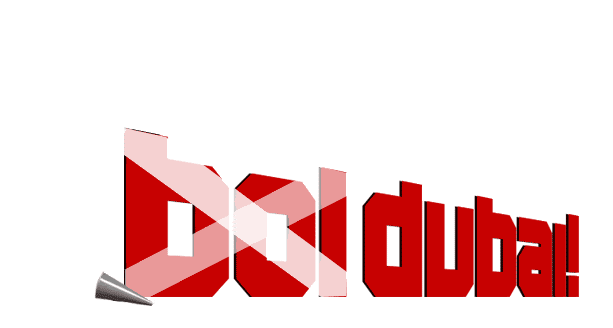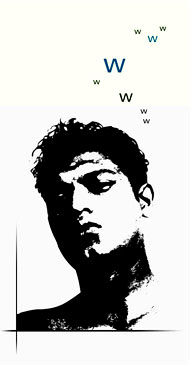Tuesday, November 28, 2006
Dubai's Tunnel of Death
After the infamous Russian tunnel video, Dubai's very own Rashidiya tunnel is getting YouTubed for all the wrong reasons.
And hey, this is not part of the "pre-plan-ned media campaign to tarnish the image of the country". Ok?
And hey, this is not part of the "pre-plan-ned media campaign to tarnish the image of the country". Ok?
Thursday, November 23, 2006
A Needle in the Number plate
A red Range Rover's rather unusual license plate might have caught your eye for a reason, but the history of license plates in UAE is no less intriguing.
1940
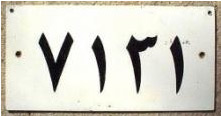 In the year 1940, though the UAE was virtually non-existent, there existed license plates which looked like these according to some sources.
In the year 1940, though the UAE was virtually non-existent, there existed license plates which looked like these according to some sources.
1962
By this time, the name of the Emirate started appearing on the number plates, mostly in Arabic and each emirate followed different standards as to their implementations for taxis, municipalities and for the members of the royal families.
1970

 The vertical divider was introduced as English made an appearance and the practice is followed till date unlike in other Arab nations. This series was considered valid till 1985.
The vertical divider was introduced as English made an appearance and the practice is followed till date unlike in other Arab nations. This series was considered valid till 1985.
1976
 All emirates except Dubai introduced a new layout often referred to as 'the quartered Arabic style'.
All emirates except Dubai introduced a new layout often referred to as 'the quartered Arabic style'.
Dubai sticked to the 1970 series until they introduced their own version 2 years later.
1978
 Although no radical changes were introduced by Dubai from the 1970-series a stardardisation took place in terms of manufacturing and customisation for other entities.
Although no radical changes were introduced by Dubai from the 1970-series a stardardisation took place in terms of manufacturing and customisation for other entities.
 During the 80's, Dubai developed rapidly and for some reason a black on yellow segment was introduced for numbers plates above 100000. (Dubai Series 1)
During the 80's, Dubai developed rapidly and for some reason a black on yellow segment was introduced for numbers plates above 100000. (Dubai Series 1)
1986

Abu Dhabi, Ras Al Khaimah, Ajman and Umm Al Quwain now got rid of the horizontal divider on the left, thus making it 3 sections.

Fujeirah and Sharjah removed the horizontal divider altogether.
 Abu Dhabi introduced the four-colour series inlcuding a grey left segment apart from the three shown here.
Abu Dhabi introduced the four-colour series inlcuding a grey left segment apart from the three shown here.
Until now these emirates have changed the formats very regularly often resorting to change in colours or layouts resulting in rather unusual number plates, many of them in good old Ras Al Khaimah. Not surprisingly, a fancy number fetched a record 18 Million Dirhams during an auction in RAK.
1992
 A rather crude outline of the Al Fahidi Fortress was introduced with the introduction of red on white colouring.
A rather crude outline of the Al Fahidi Fortress was introduced with the introduction of red on white colouring.
(Dubai series 2)
2000
 The Al Fahidi fortress outline was retained but the colour changed back to black on white as the numbering reached 300000. (Dubai series - 3)
The Al Fahidi fortress outline was retained but the colour changed back to black on white as the numbering reached 300000. (Dubai series - 3)
2001
 Dubai introduced the Burj Al Arab into the number plate starting the 4th series. This was considered to be a good change aesthetically but conspiracy theories and controversies surrounding Burj Al Arab's resemblance to the Christian cross always suggested a revision was due.
Dubai introduced the Burj Al Arab into the number plate starting the 4th series. This was considered to be a good change aesthetically but conspiracy theories and controversies surrounding Burj Al Arab's resemblance to the Christian cross always suggested a revision was due.
2004
 The revision came in 2004 when the Burj Al Arab was removed without any explanation. The series numbering changed to alphabets. Looking at the current colourless format, a change is very much on the cards. I hope they dont have plans to put a needle in the number plate.
The revision came in 2004 when the Burj Al Arab was removed without any explanation. The series numbering changed to alphabets. Looking at the current colourless format, a change is very much on the cards. I hope they dont have plans to put a needle in the number plate.
References and images:
http://www.olavsplates.com
http://plaque.free.fr
1940
 In the year 1940, though the UAE was virtually non-existent, there existed license plates which looked like these according to some sources.
In the year 1940, though the UAE was virtually non-existent, there existed license plates which looked like these according to some sources.1962
By this time, the name of the Emirate started appearing on the number plates, mostly in Arabic and each emirate followed different standards as to their implementations for taxis, municipalities and for the members of the royal families.
1970

 The vertical divider was introduced as English made an appearance and the practice is followed till date unlike in other Arab nations. This series was considered valid till 1985.
The vertical divider was introduced as English made an appearance and the practice is followed till date unlike in other Arab nations. This series was considered valid till 1985.1976
 All emirates except Dubai introduced a new layout often referred to as 'the quartered Arabic style'.
All emirates except Dubai introduced a new layout often referred to as 'the quartered Arabic style'.Dubai sticked to the 1970 series until they introduced their own version 2 years later.
1978
 Although no radical changes were introduced by Dubai from the 1970-series a stardardisation took place in terms of manufacturing and customisation for other entities.
Although no radical changes were introduced by Dubai from the 1970-series a stardardisation took place in terms of manufacturing and customisation for other entities. During the 80's, Dubai developed rapidly and for some reason a black on yellow segment was introduced for numbers plates above 100000. (Dubai Series 1)
During the 80's, Dubai developed rapidly and for some reason a black on yellow segment was introduced for numbers plates above 100000. (Dubai Series 1)1986

Abu Dhabi, Ras Al Khaimah, Ajman and Umm Al Quwain now got rid of the horizontal divider on the left, thus making it 3 sections.

Fujeirah and Sharjah removed the horizontal divider altogether.
 Abu Dhabi introduced the four-colour series inlcuding a grey left segment apart from the three shown here.
Abu Dhabi introduced the four-colour series inlcuding a grey left segment apart from the three shown here.Until now these emirates have changed the formats very regularly often resorting to change in colours or layouts resulting in rather unusual number plates, many of them in good old Ras Al Khaimah. Not surprisingly, a fancy number fetched a record 18 Million Dirhams during an auction in RAK.
1992
 A rather crude outline of the Al Fahidi Fortress was introduced with the introduction of red on white colouring.
A rather crude outline of the Al Fahidi Fortress was introduced with the introduction of red on white colouring.(Dubai series 2)
2000
 The Al Fahidi fortress outline was retained but the colour changed back to black on white as the numbering reached 300000. (Dubai series - 3)
The Al Fahidi fortress outline was retained but the colour changed back to black on white as the numbering reached 300000. (Dubai series - 3)2001
 Dubai introduced the Burj Al Arab into the number plate starting the 4th series. This was considered to be a good change aesthetically but conspiracy theories and controversies surrounding Burj Al Arab's resemblance to the Christian cross always suggested a revision was due.
Dubai introduced the Burj Al Arab into the number plate starting the 4th series. This was considered to be a good change aesthetically but conspiracy theories and controversies surrounding Burj Al Arab's resemblance to the Christian cross always suggested a revision was due.2004
 The revision came in 2004 when the Burj Al Arab was removed without any explanation. The series numbering changed to alphabets. Looking at the current colourless format, a change is very much on the cards. I hope they dont have plans to put a needle in the number plate.
The revision came in 2004 when the Burj Al Arab was removed without any explanation. The series numbering changed to alphabets. Looking at the current colourless format, a change is very much on the cards. I hope they dont have plans to put a needle in the number plate.References and images:
http://www.olavsplates.com
http://plaque.free.fr
Monday, November 20, 2006
Catching Hamoors with a Gargoor on a Shasha
That is not as bad as "Theres something Fishy about UAE", I'm sure. Now let's move on..
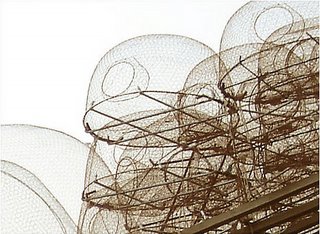
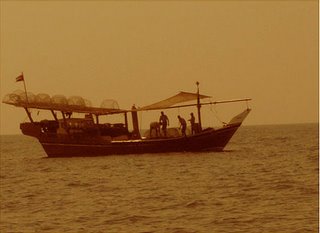
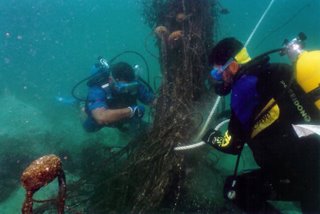

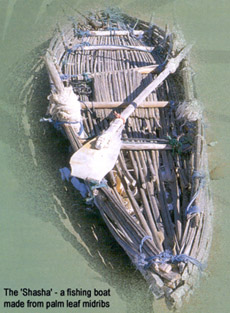
- Before oil was discovered, the people living along the coastal regions of UAE depended on the sea for their livelihood. Maritime trade, boat building, fishing nets and trap fabrication, pearl fishing, fisheries thrived during the period.
- Currently, there are more than 25,000 fishermen using 8000 fishing boats in the UAE.
- It is illegal for to carry out fishing operations without a UAE national on board.
- Fish traps locally known as Gargoor(pl. Gargeer) is a commonly used method though lines and hooks, beach line and gill nets are also used. Gargeer offers better chances of catching fresh fish than other methods.


- A Gargoor is a hemispherical steel mesh fish trap (image via) with an opening which leads the fish towards the bait. Gargeer are specially designed to allow juvenile marine species to escape and can be procured only through a written permission. It also also prevents 'ghost fishing' whereby abandoned gargeer continues to entrap fishes. Besides, abandoned gargeer can adversely affect the marine life if it is not bio-degradable.
- The Epinephelus Coioides or hamoor (ever tried finding hammour?) is considered to be the prime fish species by the local community. The rest of the world calls it 'grouper' (from the Portugese word 'garoupa') while it is 'groper' for the Aussies and the New Zealanders.
- Sultan Ibrahim is the local name of a fish - the Red Mullet.

- The 'Thorn Crown' starfish (image via) is considered to be one of the biggest threats to the coral reef in the UAE and special missions are undertaken by divers to eliminate them.

- Traditionally, the central vein of the palm leaves were used to make gargeers and other parts of the palm tree were used to make the 'shasha' (image via) or the palm reed boat.

Sunday, November 19, 2006
Do Buy! - An Interview with Omair Barkatullah
 First of all, congratulations on a very inspiring documentary film. Can you tell me briefly about your background and why you chose 'Dubai' as a subject for your documentary?
First of all, congratulations on a very inspiring documentary film. Can you tell me briefly about your background and why you chose 'Dubai' as a subject for your documentary? I took a course in Anthropological Documentary and this was my final film. I have always been interested in cities and their architecture, and how they affect people's lives. I am also interested in visual messages and how people manipulate them. Dubai is so concerned with its image and being modern and this is what makes so many go there. So Dubai seemed like an extreme example of a kind of capitalist theatre. I was interested in the strange results of the elite/natives (who people accuse of not having any culture or history) planning a city from scratch and the results of this big plan.
When you started filming 'Do Buy!', did you have a set process in mind about the message the film is going to deliver or it just evolved over a period of time?
I knew that I wanted to explore themes like:
a. Accessibility, which concerns elitism, workers and going to places in the city.
b. The mall as the only 'street' to meet other people and shopping as the only activity.
c. The fake and the real.
d. How people become anonymous in the metropolis.
e. The out-of-context things in Dubai and the sameness of all modern places.
f. Wealth, class and race groups and the narratives that surround it. And some others.
I don't know what the big conclusions in the film. I need to live in Dubai to make conclusions.
What were your initial impressions about Dubai, and is there something you found radically different from your perception about the place?
Malls are the only places to hang out. It is too hot or barren anywhere else. There is so much space and everything is so far that you need to drive. It is not a city for walking around like London.
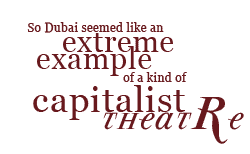 There are more Indians/Pakistanis than I expected. Not all of Dubai is glossy and well built. There are parts that look like parts of Pakistan. So much of the architecture was strange to me, like the Police Headquarters and all the towers on Sheikh Zayed Road. It is not like anything 'Western' which people said it was. It is strange.
There are more Indians/Pakistanis than I expected. Not all of Dubai is glossy and well built. There are parts that look like parts of Pakistan. So much of the architecture was strange to me, like the Police Headquarters and all the towers on Sheikh Zayed Road. It is not like anything 'Western' which people said it was. It is strange.The people appearing in your documentary were instrumental in bringing forth the contradicting emotions that the city evokes. How did you achieve this and were people apprehensive to voice their opinions on record?
No one was apprehensive about talking to the camera. I think they trusted me because I'm of Indian roots and I'm Muslim, so there was an immediate link. People are very friendly unless they are treating you like a customer.
As for contradictions there are people who think Dubai exploits workers, but then some workers love it there. Some think it is the perfect city, and others who think it is a shallow place. There are narratives and myths about the UAE Arabs. I think the views I left in are the ones that highlight things that help us interpret the images.
What are your future plans and will we be seeing more films on similar lines based in the region?
I would like to do more in the UAE, unless they have seen the film and banned me from the country. It would be great to do a longer study and a longer film. I haven't interviewed any UAE Arabs, Europeans or Filipinos as the film wasn't about them. There are many layers of inter-race, inter-cultural relations that would be interesting to look at.
And finally, would you be surprised if the security guard at the Mall of Emirates pays the price for making some insightful observations?

I think he is beyond caring. He seemed like he was dying to get his opinions out. He is a really witty man and a good observer. It may be that he is just a really bitter character generally and found a good chance to rant. I would like to get hold of him and show him the film. I think he has a huge fan club now.
------------------------------------------------------------------
Watch the 3-part documentary here.
View Omair's another documentary film Typography School in You Tube and please drop in your feedback on his You Tube page.
Thursday, November 16, 2006
How do you add life to life?
So du has finally arrived. To add life to life apparently.
A double page spread including an advertorial on some major local newspapers. How innovative for a corporate launch campaign.
After spluttering more PR and marketing bull shit than what all the Dubai Govt companies has ever managed to publish since their origin, the chairman of du finally came to the point.
"As a campaign concept, we chose an analogy that best allowed us to express these attributes. This analogy is water. The call of water is heeded by everyone, bringing people together - as does communication"
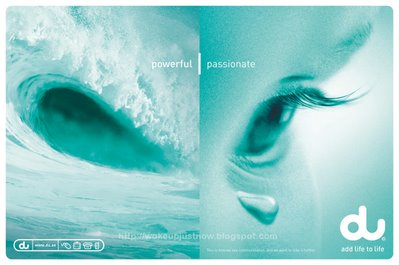
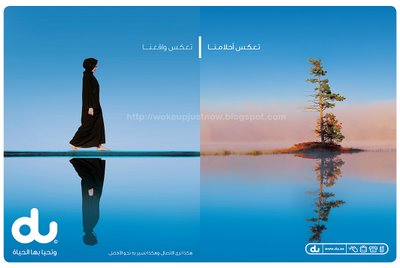
Water huh? I cannot think of water bringing people together, unless there is a flood. And I cannot make much sense out a lady walking by a pool, a tree, an ocean wave, a crying baby either. Or what 'reflects our dreams', 'reflects our reality', 'powerful' and 'passionate' has to do with water or how it 'adds life to life'. Or what it has to do with the du brand.
du. You have screwed up. Im sure the folks at Etisalat (and their agency Fp7) are smiling. Now that you have found your perfect match, you both can get married and live happily ever after.
A double page spread including an advertorial on some major local newspapers. How innovative for a corporate launch campaign.
After spluttering more PR and marketing bull shit than what all the Dubai Govt companies has ever managed to publish since their origin, the chairman of du finally came to the point.
"As a campaign concept, we chose an analogy that best allowed us to express these attributes. This analogy is water. The call of water is heeded by everyone, bringing people together - as does communication"


Water huh? I cannot think of water bringing people together, unless there is a flood. And I cannot make much sense out a lady walking by a pool, a tree, an ocean wave, a crying baby either. Or what 'reflects our dreams', 'reflects our reality', 'powerful' and 'passionate' has to do with water or how it 'adds life to life'. Or what it has to do with the du brand.
du. You have screwed up. Im sure the folks at Etisalat (and their agency Fp7) are smiling. Now that you have found your perfect match, you both can get married and live happily ever after.
Monday, November 13, 2006
The Future of Brand UAE
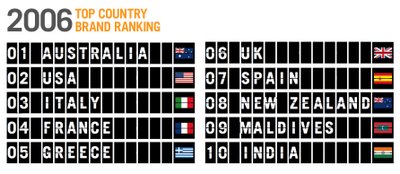 How well does your country perform as a brand?
How well does your country perform as a brand?According to a fascinating research report compiled by Futurebrand, a brand consulting and design agency which put Dubai on the world map, UAE has a long way to go before it can be classified as a successful tourism brand.
Despite it's ambitious forays into tourism, the UAE has never managed to clearly position itself as a tourism destination. Unlike many other countries which has used the diversity factor to their advantage, UAE has made no efforts so far, in terms of research or a long term marketing strategy.
The problems that UAE faces as a brand are manifold. Basking in the Arab-cosmopolitan shadow of Dubai might help UAE to bring in tourists who find the Middle East a volatile region on the short term. But as countries are increasingly consolidating their brand image as the report shows, the UAE is caught in a constant struggle between the Las Vegas of the Middle East and 6 unexplored regional identities.
Country Brand Index - How UAE fared
Rising Star - UAE is rated #3
Likely to become major tourist destinations in next five years
Resort/Lodging Options - UAE is rated #10
Wide variety and superior selection of accommodations
Conferences - UAE is rated #9
Preferred off-site/convention destinations
Shopping - UAE is rated rated #4
Accessible, abundant and diverse retail options
So what is UAE missing?
Authenticity, History, Art & Culture, Families, Natural Beauty, Off The Beaten Track/Exotic locations, Outdoor Activities/Sports etc for a start.
Take a look at the full report.
Encounters of the Dubai kind
The man's eyes were undoubtedly fixed on me. Briefly he scoured the cars zipping by. There was a certain determination on his face that I found unnerving.
Maybe he is going to pull out a gun and start a shooting spree. But this is Dubai, so he would probably threaten me with a knife and demand to take out my wallet. I mentally counted the money in my purse - thankfully not enough make my months survival difficult but then not enough to make this man happy with his hunt either.
As I walked towards him, he glanced at the maroon Nissan Sunny parked nearby. Maybe he is a kidnapper. Or just some maniac. Holding my breath and pretending to be a Casino Royale toying with danger on a daily basis, I decided to walk on. As I swiftly walked past him with a new found courage, I couldn't catch his facial expression, but what he said was unmistakable.
"You want car lift?"
Maybe he is going to pull out a gun and start a shooting spree. But this is Dubai, so he would probably threaten me with a knife and demand to take out my wallet. I mentally counted the money in my purse - thankfully not enough make my months survival difficult but then not enough to make this man happy with his hunt either.
As I walked towards him, he glanced at the maroon Nissan Sunny parked nearby. Maybe he is a kidnapper. Or just some maniac. Holding my breath and pretending to be a Casino Royale toying with danger on a daily basis, I decided to walk on. As I swiftly walked past him with a new found courage, I couldn't catch his facial expression, but what he said was unmistakable.
"You want car lift?"
Ah the Irony!
"But the irony of the whole issue at hand here is that HRW distributed its report and openly discussed its contents at a press conference, of all places, here in the UAE. "
Gulf News Editorial on a HRW report criticising the abuse of labourers in the UAE.
No. The irony is that a supposedly independent newspaper is so pained by such a report and the fact that it was 'openly' discussed, of all places in the UAE.
What do you suggest then? Ethiopia?
Gulf News Editorial on a HRW report criticising the abuse of labourers in the UAE.
No. The irony is that a supposedly independent newspaper is so pained by such a report and the fact that it was 'openly' discussed, of all places in the UAE.
What do you suggest then? Ethiopia?
Thursday, November 09, 2006
Flickr it!
 There are some spectacular photos of the UAE in Flickr - which we have been missing for too long, thanks to etisalat.
There are some spectacular photos of the UAE in Flickr - which we have been missing for too long, thanks to etisalat.Check Hupaishi's gallery.
But then, nothing like home either.
As ezee as hell reminded me.




Tuesday, November 07, 2006
A huge leap for UAE, one baby step for democracy
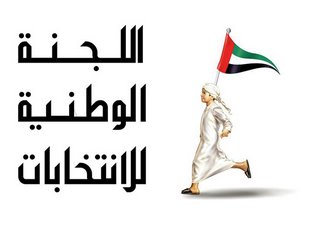 Congratulations if you are one among the 6689 people eligible to cast a vote to elect half of the 40-member Federal National Council of UAE. If you are one, good to know that there is a 17.77% chance that you are a woman. Though the ruling families gets to choose the 6689 voters and also 'the better half' of the council, I am sure the FNC will do a fantastic job as an advisory board with no legislative powers.
Congratulations if you are one among the 6689 people eligible to cast a vote to elect half of the 40-member Federal National Council of UAE. If you are one, good to know that there is a 17.77% chance that you are a woman. Though the ruling families gets to choose the 6689 voters and also 'the better half' of the council, I am sure the FNC will do a fantastic job as an advisory board with no legislative powers.The last time I casted a vote, I had to choose between a communist poet, an agnostic christian, a hindu fundamentalist and my college mate who used an apple as his election symbol. Though I missed being poked on my finger with stamp ink, I did enjoy standing in the queue alongside a surprisingly sober toddy addict, a professional coconut tree climber(what else do you call them), a dozen communist activists and some muslim relatives marvelling at the electronic voting machine.
The light at the end of the tunnel is fortunately not an approaching train(we will have to wait longer for the Dubai metro, don't we?), but a lit-up matchstick. Atleast that is what Asda'a is trying to tell us.
Wednesday, November 01, 2006
A farce called Arabian Property Awards
The past week saw some Dubai based property companies were celebrating their 'win' at the CNBC Arabian Property Awards with full page advertisements and press releases. Damac Properties, ETA Star, Trident, Le Rêve and the likes trumpeted their achievements on having won the 'oscars of the property industry'.
But have you wondered how these awards are judged and what is the criteria for winning? If you look beyond the 3-d generated renderings and glossy brochures this is what you see.
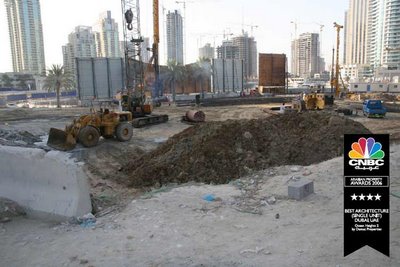
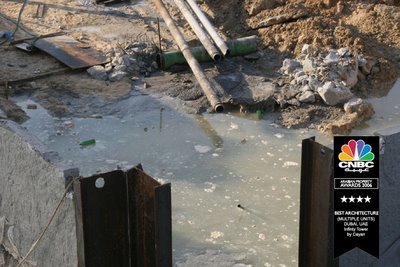
But have you wondered how these awards are judged and what is the criteria for winning? If you look beyond the 3-d generated renderings and glossy brochures this is what you see.
Best Architecture - Dubai (Single Unit)

Best Architecture - Dubai(Multiple Units)

Best Marina Development in Dubai
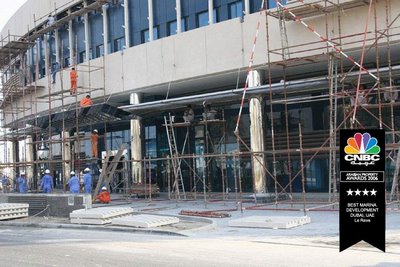

So where is the architecture in a pile of sand and some earth movers? And is the marina views about construction workers fixing concrete slabs?
The truth is, if you can donate $420 to the award organisers, put together an entry with your dream home (made with 3D Home Architect) and make it rotate, you can be the next recipient of the Arabian Property Award. Oh yes, and you can tell them you are planning to build it in Swaziland, in case they ask.
The truth is, if you can donate $420 to the award organisers, put together an entry with your dream home (made with 3D Home Architect) and make it rotate, you can be the next recipient of the Arabian Property Award. Oh yes, and you can tell them you are planning to build it in Swaziland, in case they ask.
Construction photos courtesy : Skyscrapercity
